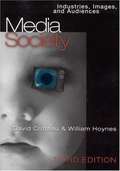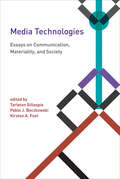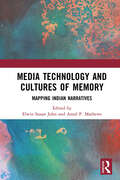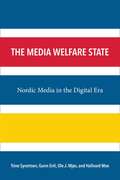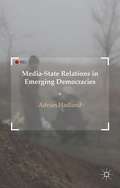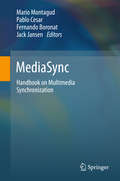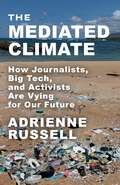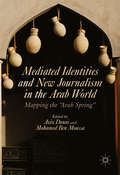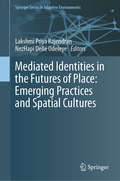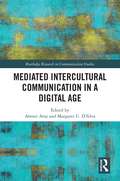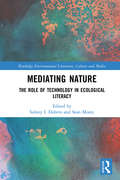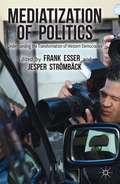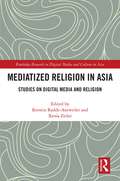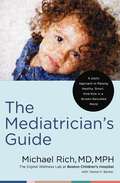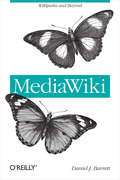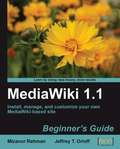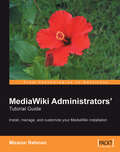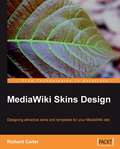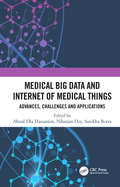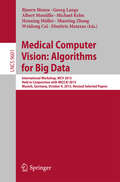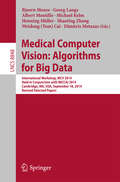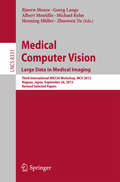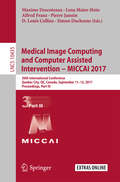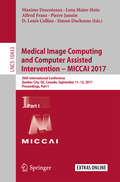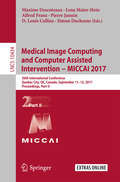- Table View
- List View
Media/Society: Industries, Images, and Audiences
by David Croteau William HoynesPresenting the new edition of their undergraduate-level textbook, Croteau (sociology and anthropology, Virginia Commonwealth U.) and Hoynes (sociology, Vassar College) discuss the social components of the mass media and highlight the tension between constraint and action. Their analysis is based on a social model that sees media as being part of multidimensional process of complex interaction between audiences, technology, medial message, and media industry, all operating within the wider context of the social world. Annotation c. Book News, Inc., Portland, OR (booknews.com)
Media Technologies: Essays on Communication, Materiality, and Society (Inside Technology)
by Tarleton Gillespie Kirsten A. Foot Pablo J. BoczkowskiScholars from communication and media studies join those from science and technology studies to examine media technologies as complex, sociomaterial phenomena.In recent years, scholarship around media technologies has finally shed the assumption that these technologies are separate from and powerfully determining of social life, looking at them instead as produced by and embedded in distinct social, cultural, and political practices. Communication and media scholars have increasingly taken theoretical perspectives originating in science and technology studies (STS), while some STS scholars interested in information technologies have linked their research to media studies inquiries into the symbolic dimensions of these tools. In this volume, scholars from both fields come together to advance this view of media technologies as complex sociomaterial phenomena. The contributors first address the relationship between materiality and mediation, considering such topics as the lived realities of network infrastructure. The contributors then highlight media technologies as always in motion, held together through the minute, unobserved work of many, including efforts to keep these technologies alive.ContributorsPablo J. Boczkowski, Geoffrey C. Bowker, Finn Brunton, Gabriella Coleman, Gregory J. Downey, Kirsten A. Foot, Tarleton Gillespie, Steven J. Jackson, Christopher M. Kelty, Leah A. Lievrouw, Sonia Livingstone, Ignacio Siles, Jonathan Sterne, Lucy Suchman, Fred Turner
Media Technology and Cultures of Memory: Mapping Indian Narratives
by Elwin Susan John Amal P. MathewsMedia Technology and Cultures of Memory studies narrative memories in India through oral, chirographic and digital cultures. It examines oral cultures of memory culled from diverse geographical and cultural landscapes of India and throws light on multiple aspects of remembering and registering the varied cultural tapestry of the country. The book also explores themes such as oral culture and memory markers; memory and its paratextual services; embodied memory practices in the cultural traditions; between myths and monuments; literary and lived experiences; print culture and memory markers; marginalized memories in hagiographies; displaying memories online; childhood trauma, memory and flashbacks; and the politics of remembering and forgetting. Rich in case studies from across India, this interdisciplinary book is a must-read for scholars and researchers of cultural studies, sociology, political science, English literature, South Asian studies, social anthropology, social history, and post-colonial studies.
The Media Welfare State: Nordic Media In The Digital Era
by Ole J. Mjøs Hallvard Moe Trine Syvertsen Gunn Sara EnliThe Media Welfare State: Nordic Media in the Digital Era comprehensively addresses the central dynamics of the digitalization of the media industry in the Nordic countries--Sweden, Norway, Denmark, Finland, and Iceland--and the ways media organizations there are transforming to address the new digital environment. Taking a comparative approach, the authors provide an overview of media institutions, content, use, and policy throughout the region, focusing on the impact of information and communication technology/internet and digitalization on the Nordic media sector. Illustrating the shifting media landscape the authors draw on a wide range of cases, including developments in the press, television, the public service media institutions, and telecommunication.
Media�State Relations in Emerging Democracies
by Adrian HadlandThe news media and the state are locked in a battle of wills in the world's emerging democratic states. It is a struggle that will determine whether or not democracy flourishes or withers in the 21st century. Using a number of case studies, including South Africa, this book evaluates what is at stake.
MediaSync: Handbook On Multimedia Synchronization
by Mario Montagud Pablo Cesar Fernando Boronat Jack JansenThis book provides an approachable overview of the most recent advances in the fascinating field of media synchronization (mediasync), gathering contributions from the most representative and influential experts. Understanding the challenges of this field in the current multi-sensory, multi-device, and multi-protocol world is not an easy task. The book revisits the foundations of mediasync, including theoretical frameworks and models, highlights ongoing research efforts, like hybrid broadband broadcast (HBB) delivery and users’ perception modeling (i.e., Quality of Experience or QoE), and paves the way for the future (e.g., towards the deployment of multi-sensory and ultra-realistic experiences). Although many advances around mediasync have been devised and deployed, this area of research is getting renewed attention to overcome remaining challenges in the next-generation (heterogeneous and ubiquitous) media ecosystem. Given the significant advances in this research area, its current relevance and the multiple disciplines it involves, the availability of a reference book on mediasync becomes necessary. This book fills the gap in this context. In particular, it addresses key aspects and reviews the most relevant contributions within the mediasync research space, from different perspectives. Mediasync: Handbook on Multimedia Synchronization is the perfect companion for scholars and practitioners that want to acquire strong knowledge about this research area, and also approach the challenges behind ensuring the best mediated experiences, by providing the adequate synchronization between the media elements that constitute these experiences.
The Mediated Climate: How Journalists, Big Tech, and Activists Are Vying for Our Future
by Adrienne RussellTo what extent does journalism deserve blame for the failure to address climate change over the last thirty years? Critics point out that climate coverage has often lacked necessary urgency and hewed to traditional notions of objectivity and balance that allowed powerful interests—mainly fossil fuel companies—to manufacture doubt. Climate journalism, however, developed alongside the digital media landscape, which is characterized by rampant misinformation, political polarization, unaccountable tech companies, unchecked corporate power, and vast inequalities. Under these circumstances, journalism struggled, and bad actors flourished, muddling messages while emissions mounted and societies struggled to avert catastrophe.The Mediated Climate explores the places where the climate and information crises meet, examining how journalism, activism, corporations, and Big Tech compete to influence the public. Adrienne Russell argues that the inadequate response to climate change is intertwined with the profound challenges facing the communications environment. She demonstrates that the information crisis is driven not only by technological changes but also by concentrated power that predates the rise of digital media companies. Efforts to improve climate coverage must take into account the larger social and material contexts in which journalism operates and the broader power dynamics that shape public discourse. Drawing on interviews with journalists and activists, Russell considers the ways recent movements are battling misinformation. She offers timely recommendations to foster engagement with climate issues and calls on readers to join in efforts to reshape the media landscape to better serve the public interest.
Mediated Identities and New Journalism in the Arab World
by Mohamed Ben Moussa Aziz DouaiThis book looks into the role played by mediated communication, particularly new and social media, in shaping various forms of struggles around power, identity and religion at a time when the Arab world is going through an unprecedented period of turmoil and upheaval. The book provides unique and multifocal perspectives on how new forms of communication remain at the centre of historical transformations in the region. The key focus of this book is not to ascertain the extent to which new communication technologies have generated the Arab spring or led to its aftermaths, but instead question how we can better understand many types of articulations between communication technologies, on the one hand, and forms of resistance, collective action, and modes of expression that have contributed to the recent uprisings and continue to shape the social and political upheavals in the region on the other. The book presents original perspectives and rigorous analysis by specialists and academics from around the world that will certainly enrich the debate around major issues raised by recent historical events.
Mediated Identities in the Futures of Place: Emerging Practices and Spatial Cultures (Springer Series in Adaptive Environments)
by Lakshmi Priya Rajendran NezHapi Dellé OdeleyeThis book examines the emerging problems and opportunities that are posed by media innovations, spatial typologies, and cultural trends in (re)shaping identities within the fast-changing milieus of the early 21st Century.Addressing a range of social and spatial scales and using a phenomenological frame of reference, the book draws on the works of Heidegger, Merleau-Ponty and Don Hide to bridge the seemingly disparate, yet related theoretical perspectives across a number of disciplines. Various perspectives are put forward from media, human geography, cultural studies, technologies, urban design and architecture etc. and looked at thematically from networked culture and digital interface (and other) perspectives.The book probes the ways in which new digital media trends affect how and what we communicate, and how they drive and reshape our everyday practices. This mediatization of space, with fast evolving communication platforms and applications of digital representations, offers challenges to our notions of space, identity and culture and the book explores the diverse yet connected levels of technology and people interaction.
Mediated Intercultural Communication in a Digital Age (Routledge Research in Communication Studies)
by Ahmet Atay Margaret U. D'SilvaThis book focuses on mediated intercultural communication in the context of globalization. Analyzing social and traditional media using qualitative, interpretive, and critical and cultural perspectives, contributors engage with diverse topics - ranging from hybrid identities in different communities, to journalistic collaborations in the global media landscape. In addition, the authors also examine the placeless and borderless communities of diaspora members, their transnational identities, and the social media stories that shape and are shaped by them.
Mediating Nature: The Role of Technology in Ecological Literacy (Routledge Environmental Literature, Culture and Media)
by Sidney I. Dobrin Sean MoreyMediating Nature considers how technology acts as a mediating device in the construction and circulation of images that inform how we see and know nature. Scholarship in environmental communication has focused almost exclusively on verbal rather than visual rhetoric, and this book engages ecocritical and ecocompositional inquiry to shift focus onto the making of images. Contributors to this dynamic collection focus their efforts on the intersections of digital media and environmental/ecological thinking. Part of the book’s larger argument is that analysis of mediations of nature must develop more critical tools of analysis toward the very mediating technologies that produce such media. That is, to truly understand mediations of nature, one needs to understand the creation and production of those mediations, right down to the algorithms, circuit boards, and power sources that drive mediating technologies. Ultimately, Mediating Nature contends that ecological literacy and environmental politics are inseparable from digital literacies and visual rhetorics. The book will be of interest to scholars and students working in the fields of Ecocriticism, Ecocomposition, Media Ecology, Visual Rehtoric, and Digital Literacy Studies.
Mediatization of Politics
by Frank Esser Jesper Str�mb�ckThe first book-long analysis of the 'mediatization of politics', this volume aims to understand the transformations of the relationship between media and politics in recent decades, and explores how growing media autonomy, journalistic framing, media populism and new media technologies affect democratic processes.
Mediatized Religion in Asia: Studies on Digital Media and Religion (Routledge Research in Digital Media and Culture in Asia)
by Kerstin Radde-Antweiler Xenia ZeilerThis edited volume discusses mediatized religion in Asia, examining the intensity and variety of constructions and processes related to digital media and religion in Asia today. Individual chapters present case studies from various regions and religious traditions in Asia, critically discussing the data collected in light of current mediatization theories. By directing the study to the geographical, cultural and religious contexts specific to Asia, it also provides new material for the theoretical discussion of the pros and cons of the concept mediatization, among other things interrogating whether this concept is useful in non-’Western’ contexts."
The Mediatrician's Guide: A Joyful Approach to Raising Healthy, Smart, Kind Kids in a Screen-Saturated World
by Michael Rich, MD, MPHGain the confidence you need to raise a child well in the digital age.In this positive, science-based approach, Dr. Michael Rich addresses your questions and concerns about your childrens&’ screen time and media use. The Mediatrician&’s Guide empowers you to guide your family toward smart and healthy digital choices.Known as the &“Mediatrician&” due to his acclaimed work as a pediatrician, child health researcher, and children&’s media specialist, Dr. Rich presents a compassionate and encouraging look at the reality of growing up in a screen-saturated world. You won&’t find fearmongering here—just accessible explanations, case studies, and practical tips to help your kids thrive in a technology-rich environment and emerge as happy, well-informed, empathetic adults.Features include:Ask the Mediatrician: Questions and answers based on Dr. Rich&’s long-running advice column and podcastMedia Rx: Prescriptive content based on insights from the Digital Wellness Lab and the Clinic for Interactive Media and Internet DisordersYou Can: Straightforward instructions for what you can do to guide your child in the digital landscapeDigital Wellness Primer: A one-stop resource for actionable advice that you can customize for your family&’s specific needsBacked by evidence as well as decades of professional and personal practice, The Mediatrican's Guide will give you peace of mind and your kids much-needed tools to navigate the digital environment in a way that reduces the risks to their physical and mental health and their emotional and social development..&“A caring, wise, and joyful guide to the possibilities and the perils of our increasingly more digital existence.&”—Marlo Thomas, activist, actor, and author&“This book is a must-have and will soon become your best friend, full of daily tips and long-lasting wisdom.&”—Sanjay Gupta, MD,associate professor of neurosurgery, Emory, and chief medical correspondent, CNN
MediaWiki: Wikipedia and Beyond (Wikipedia and Beyond)
by Daniel J. Barrett"A good book! It's a nice overview of wiki editing and administration, with pointers to handy extensions and further online documentation." -Brion Vibber, Chief Technical Officer, Wikimedia Foundation "This book is filled with practical knowledge based on experience. It's not just spouting some party line." -Rob Church, a developer of MediaWiki MediaWiki is the world's most popular wiki platform, the software that runs Wikipedia and thousands of other websites. Though it appears simple to use at first glance, MediaWiki has extraordinarily powerful and deep capabilities for managing and organizing knowledge. In corporate environments, MediaWiki can transform the way teams write and collaborate. This comprehensive book covers MediaWiki's rich (and sometimes subtle) features, helping you become a wiki expert in no time. You'll learn how to:Find your way around by effective searching and browsing Create and edit articles, categories, and user preferences Use advanced features for authors, such as templates, dynamic lists, logical parser functions, and RSS, to organize and maintain large numbers of articles Install and run your own wiki, and configure its look and behavior Develop custom wiki features, called extensions, with the PHP programming language and MySQL database This book also provides special guidance for creating successful corporate wikis. For beginners who want to create or work on collaborative, community-driven websites with this platform, MediaWiki is the essential one-stop guide. "I was a MediaWiki newbie before reading this book. Now, many aspects of the platform that were murky before are crystal clear." -JP Vossen, author of O'Reilly's Bash Cookbook
MediaWiki 1.1 Beginner's Guide
by Jeff Orlof Mizanur RahmanThis book was written with the beginner in mind. It walks you through step-by-step exercises and makes use of illustrations to show exactly what is going on in each. You will be taken through exercises that not only help you to build a solid, secure wiki, but provide a foundation on which you can build and challenge yourself to learn even more. Throughout the book, you will follow along as a wiki dedicated to free/open source software built from the ground up. If you are a Web Designer, IT Administrator or Executive, or a Programmer and wish to gain a solid foundation in the MediaWiki software application, then this book is for you.
MediaWiki Administrators’ Tutorial Guide
by Mizanur RahmanThe power that makes MediaWiki so popular also makes it daunting for many would-be administrators. This book puts MediaWiki in the hands of busy administrators with no time for trial and error, enabling them to get their site up and running quickly and easily. A fun example that runs through the book holds everything together as you see how a real site develops and improves as more and more features of MediaWiki are used. This book is for competent computer users who want to run MediaWiki. They should have some knowledge of HTML and have used a wiki before. No PHP knowledge is required for most of the book, although some chapters at the end include some PHP code.
MediaWiki Skins Design
by Richard CarterThis book takes you step by step through customizing your MediaWiki skin. It is full of practical examples of MediaWiki skinning techniques, and clear explanations of how MediaWiki skinning works. The early chapters go through each element of a MediaWiki design, showing the CSS and PHP tags necessary to customize MediaWiki's appearance. Later chapters look at ways to further enhance your design using extra graphics, JavaScript, AJAX, dynamic CSS, and more. This book is aimed at web designers or wiki administrators who want to customize the look of MediaWiki with custom skins. The reader will already have a MediaWiki installation that they are targeting with their skin. It might be their own installation, or they might be a designer developing a custom look for a client. The book does not cover setting up or using MediaWiki, except features specifically related to skinning. The book assumes that you are familiar with CSS and HTML, but no prior knowledge of PHP is required.
Medical Big Data and Internet of Medical Things: Advances, Challenges and Applications
by Aboul Ella Hassanien, Nilanjan Dey and Surekha BorraBig data and the Internet of Things (IoT) play a vital role in prediction systems used in biological and medical applications, particularly for resolving issues related to disease biology at different scales. Modelling and integrating medical big data with the IoT helps in building effective prediction systems for automatic recommendations of diagnosis and treatment. The ability to mine, process, analyse, characterize, classify and cluster a variety and wide volume of medical data is a challenging task. There is a great demand for the design and development of methods dealing with capturing and automatically analysing medical data from imaging systems and IoT sensors. Addressing analytical and legal issues, and research on integration of big data analytics with respect to clinical practice and clinical utility, architectures and clustering techniques for IoT data processing, effective frameworks for removal of misclassified instances, practicality of big data analytics, methodological and technical issues, potential of Hadoop in managing healthcare data is the need of the hour. This book integrates different aspects used in the field of healthcare such as big data, IoT, soft computing, machine learning, augmented reality, organs on chip, personalized drugs, implantable electronics, integration of bio-interfaces, and wearable sensors, devices, practical body area network (BAN) and architectures of web systems. Key Features: Addresses various applications of Medical Big Data and Internet of Medical Things in real time environment Highlights recent innovations, designs, developments and topics of interest in machine learning techniques for classification of medical data Provides background and solutions to existing challenges in Medical Big Data and Internet of Medical Things Provides optimization techniques and programming models to parallelize the computationally intensive tasks in data mining of medical data Discusses interactions, advantages, limitations, challenges and future perspectives of IoT based remote healthcare monitoring systems. Includes data privacy and security analysis of cryptography methods for the Web of Medical Things (WoMT) Presents case studies on the next generation medical chair, electronic nose and pill cam are also presented.
Medical Computer Vision: Algorithms for Big Data
by Bjoern Menze Georg Langs Albert Montillo Michael Kelm Henning Müller Shaoting Zhang Weidong Cai Dimitris MetaxasThis book constitutes the thoroughly refereed prost-workshop proceedings of the International Workshop on Medical Computer Vision: Algorithms for Big Data, MCS 2015, held in Munich, Germany, in October 2015, held in conjunction with the 18th International Conference on Medical Image Computing and Computer-Assisted Intervention, MICCAI 2015. The workshop shows well the current trends and tendencies in medical computer vision and how the techniques can be used in clinical work and on large data sets. It is organized in the following sections: predicting disease; atlas exploitation and avoidance; machine learning based analyses; advanced methods for image analysis; poster sessions. The 10 full, 5 short, 1 invited papers and one overview paper presented in this volume were carefully reviewed and selected from 22 submissions.
Medical Computer Vision: Algorithms for Big Data
by Bjoern Menze Georg Langs Albert Montillo Michael Kelm Henning Müller Shaoting Zhang Weidong Tom Cai Dimitris MetaxasThis book constitutes the thoroughly refereed post-workshop proceedings of the International Workshop on Medical Computer Vision: Algorithms for Big Data, MCV 2014, held in Cambridge, MA, USA, in September 2019, in conjunction with the 17th International Conference on Medical Image Computing and Computer-Assisted Intervention, MICCAI 2014. The one-day workshop aimed at exploring the use of modern computer vision technology and "big data" algorithms in tasks such as automatic segmentation and registration, localization of anatomical features and detection of anomalies emphasizing questions of harvesting, organizing and learning from large-scale medical imaging data sets and general-purpose automatic understanding of medical images. The 18 full and 1 short papers presented in this volume were carefully reviewed and selected from 30 submission.
Medical Computer Vision. Large Data in Medical Imaging: Third International MICCAI Workshop, MCV 2013, Nagoya, Japan, September 26, 2013, Revised Selected Papers (Lecture Notes in Computer Science #8331)
by Bjoern Menze, Georg Langs, Albert Montillo, Michael Kelm, Henning Müller and Zhuowen TuThis book constitutes the thoroughly refereed post-workshop proceedings of the Third International Workshop on Medical Computer Vision, MCV 2013, held in Nagoya, Japan, in September 2013 in conjunction with the 16th International Conference on Medical Image Computing and Computer-Assisted Intervention, MICCAI 2013. The 7 revised full papers and 12 poster papers presented were selected from 25 submissions. They have been organized in topical sections on registration and visualization, segmentation, detection and localization, and features and retrieval. In addition, the volume contains two invited papers describing segmentation task and data set of the VISCERAL benchmark challenge.
Medical Image Computing and Computer-Assisted Intervention − MICCAI 2017: 20th International Conference, Quebec City, QC, Canada, September 11-13, 2017, Proceedings, Part III (Lecture Notes in Computer Science #10435)
by Pierre Jannin Maxime Descoteaux Lena Maier-Hein Alfred Franz D. Louis Collins Simon DuchesneThe three-volume set LNCS 10433, 10434, and 10435 constitutes the refereed proceedings of the 20th International Conference on Medical Image Computing and Computer-Assisted Intervention, MICCAI 2017, held in Quebec City, Canada, in September 2017. The 255 revised full papers presented were carefully reviewed and selected from 800 submissions in a two-phase review process. The papers have been organized in the following topical sections: Part I: atlas and surface-based techniques; shape and patch-based techniques; registration techniques, functional imaging, connectivity, and brain parcellation; diffusion magnetic resonance imaging (dMRI) and tensor/fiber processing; and image segmentation and modelling. Part II: optical imaging; airway and vessel analysis; motion and cardiac analysis; tumor processing; planning and simulation for medical interventions; interventional imaging and navigation; and medical image computing. Part III: feature extraction and classification techniques; and machine learning in medical image computing.
Medical Image Computing and Computer Assisted Intervention − MICCAI 2017: 20th International Conference, Quebec City, QC, Canada, September 11-13, 2017, Proceedings, Part I (Lecture Notes in Computer Science #10433)
by Pierre Jannin Maxime Descoteaux Lena Maier-Hein Alfred Franz D. Louis Collins Simon DuchesneThe three-volume set LNCS 10433, 10434, and 10435 constitutes the refereed proceedings of the 20th International Conference on Medical Image Computing and Computer-Assisted Intervention, MICCAI 2017, held in Quebec City, Canada, in September 2017. The 255 revised full papers presented were carefully reviewed and selected from 800 submissions in a two-phase review process. The papers have been organized in the following topical sections: Part I: atlas and surface-based techniques; shape and patch-based techniques; registration techniques, functional imaging, connectivity, and brain parcellation; diffusion magnetic resonance imaging (dMRI) and tensor/fiber processing; and image segmentation and modelling. Part II: optical imaging; airway and vessel analysis; motion and cardiac analysis; tumor processing; planning and simulation for medical interventions; interventional imaging and navigation; and medical image computing. Part III: feature extraction and classification techniques; and machine learning in medical image computing.
Medical Image Computing and Computer-Assisted Intervention − MICCAI 2017: 20th International Conference, Quebec City, QC, Canada, September 11-13, 2017, Proceedings, Part II (Lecture Notes in Computer Science #10434)
by Pierre Jannin Maxime Descoteaux Lena Maier-Hein Alfred Franz D. Louis Collins Simon DuchesneThe three-volume set LNCS 10433, 10434, and 10435 constitutes the refereed proceedings of the 20th International Conference on Medical Image Computing and Computer-Assisted Intervention, MICCAI 2017, held in Quebec City, Canada, in September 2017. The 255 revised full papers presented were carefully reviewed and selected from 800 submissions in a two-phase review process. The papers have been organized in the following topical sections: Part I: atlas and surface-based techniques; shape and patch-based techniques; registration techniques, functional imaging, connectivity, and brain parcellation; diffusion magnetic resonance imaging (dMRI) and tensor/fiber processing; and image segmentation and modelling. Part II: optical imaging; airway and vessel analysis; motion and cardiac analysis; tumor processing; planning and simulation for medical interventions; interventional imaging and navigation; and medical image computing. Part III: feature extraction and classification techniques; and machine learning in medical image computing.
